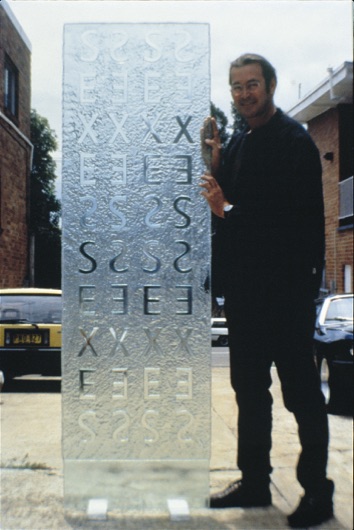Code Red, 2019. Pine timber, plywood, enamel paint. Dimensions 130 x 130 x 14 cm.
Code Red means an emergency alert code. Code Red is a portrait of the social world in a time of anxiety. On the iconic ‘stop’ of a red octagon, five symbols stand in raised blocks, representing (left to right) nuclear power, humankind, the future; and (top to bottom) missile weaponry, humankind, fear. When combined, these create a dynamic field where a complex of possible meanings self-generate. These symbols were designed in 1984 during an artist residency near to Milan in Italy thanks to the Australia Council, and made as cut-outs in black card. At the time it felt like the world could end through nuclear war between the USSR and the USA at any time. Thirty five years later we live in a similar state of anxiety, and now with the added fear of plaque and climate change.The symbol shapes are black with silver edging, standing on a bright red background, which gives a solid sculptural dimension. The finish using automotive enamel paint provides extra visual depth and resilience.


Division of the Sexes is a typographic concrete poem in slump glass made with Warren Langley in 1997. Exhibited in London at the Eagle Gallery, Sexes has recently returned and this will be its first showing in Australia. The symmetry of repeated letters is reminiscent of DNA replication.

Richard Tipping with Division of the Sexes outside the Ozone factory in 1997. Photo by Warren Langley




The front window of WordXimage showing the Big Works exhibition
Top Paddock ('ooroo'), engraved glass bricks including Stone Cold Sober at Last, and Division of the Sexes in large slump glass
Big Works at WXI including Jump Start ('ooroo'); The Relative (E=MC2) in both full size stainless steel and wooden maquettes; and Come In We're Closed
Big Works at WXI including The Relative (E=MC2) in wooden maquettes; Submerging Artist; and Code Red

Near Encounter Bay, 2019 Dimensions: H 120 x W 300 x D 3 cmMaterials: Reflective tape and vinyl letters on aluminium, brass letters, Aboriginal wooden spear, wooden oar, cane fishing rod, bakelite reel, wild seaweed balls from Waitpinga Beach in South Australia.

NEAR ENCOUNTER BAY
i have come home
to myth, i have come
in this weather
to pitch a bare shelter
and keep watch
alone, till flaps cut
loose, burst into fire
from the jib ...
! sea-wind, spray
flabbergast of waves
rocks, waving farewell
to ships going down
to candleflame
spitting moths - dream
wildly my sweet
of fishermen, their heads
of salmon, salmon-kind
poled to the sand
on their bellies like men
gasping for air
.... continued >>
their thirst, after water
dying of song
“if whales could scream
there'd be no man a whaler”
but her eyes! we toss
together leaner than knives
our skin of salt
our sailors' kisses
dowsed with ale!
not cuttlefish, driftwood
the sighing of whales
going down, the fear
of sand blowing back from bone
of bone laid bare
and splintering with rain –
“wake up, wake up,
we are here!”
Richard Tipping 1973
Artist statement:
"Three wooden artefacts – an old hand-made oar, an original Aboriginal hunting spear, and a salmon-fishing pole from sixty years ago –-reference cultures in the littoral zone of the coast. The poem recounts fishing, whaling, a wreck, and early European exploration and settlement in South Australia.
Near Encounter Bay brings a potent poem living history in the landscape into an assembled sculptural form. The poem in vinyl letters is held on a reflective sign to be read by the viewer as a spoken balance to the silent colour-test of the background. The letters and ampersands of S & E & A make the SEA with waves, in a never still horizon."
Richard Tipping bridges poetic writing and visual arts through concrete poetry and word sculpture. BIG WORKS presents a few sculptures and wall-works made over the past five years in the field of sign language. 1 to 26 May 2021
30 September to 1

